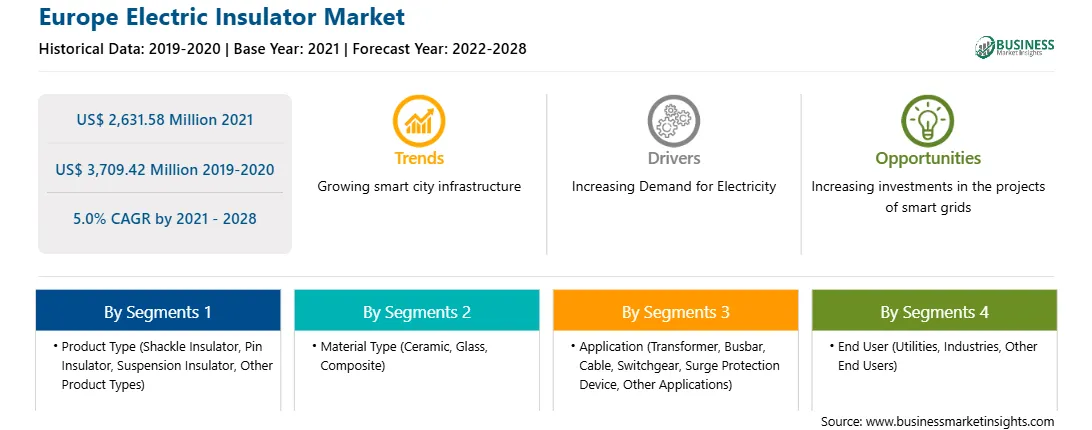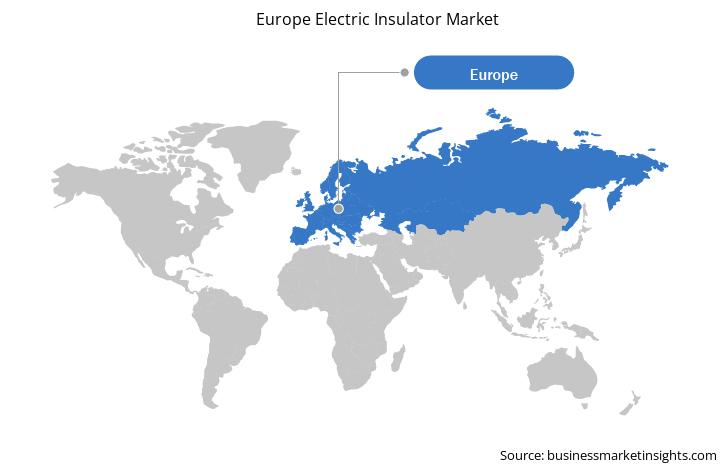Europe includes various well-established economies such as France, Germany, Russia, the UK, and Italy. The growth in the electric insulator market across the region can be attributed to the construction of transmission and distribution lines, upgrading of power infrastructure, and government investments. For instance, in July 2021, the construction of a network interconnector in the North Sea around the UK and Norway began. After completion, the North Sea network interconnector will be the world’s longest subsea electricity cable with a voltage capacity of ±500 kV, high voltage direct current (HVDC). Similarly, in June 2021, Litgrid AB and Polskie Sieci Elektroenergetyczne SA (PSE) started the construction of an electric grid. The project of the undersea link will synchronize the Baltic States’ electricity grid with Continental Europe, which will take place via Poland with the existing alternating current (AC) link (between Lithuania and Poland) and Harmony Link, as decided in a political agreement signed on June 28, 2018, by the Baltic States, Poland, and the European Commission (EC). Further, in July 2021, Latvian transmission system operator, Augstsprieguma Tikls announced that it is planning to invest approximately EUR 400 million in grid development over the next ten years. Therefore, owing to several projects and investments to support the electric and power distribution sector, the demand for electric insulators will also rise. The region has several electric insulator manufacturers such as ABB Ltd, PFISTERER Holding AG, SEVES Group, Siemens AG, and TE Connectivity Ltd. These manufacturers are offering different kinds of electric insulators including shackle insulator, pin insulator, suspension insulator, strain insulator or tension insulator, post insulator, and stay insulator. This will also help in the growth of the electric insulator market in the region.
In case of COVID-19, France is one of the hardest-hit countries by the outbreak across Europe region. It is expected to suffer an economic hit due to a lack of revenue from various industries. Additionally, with the outbreak of another variant of COVID-19 in the UK, the electric insulator manufacturing in industries is expected to get hampered. The region is a significant manufacturing and industrial hub for sectors such as healthcare, aviation, manufacturing, automotive, and energy & power. Further, due to COVID-19 impact, the demand for electricity in the region decreases, as in 2020, the demand from the commercial sector in UK fell to negative 25% in second quarter. However, in 2021, with the uplifting of lockdowns and vaccination processes, the demand for electricity in industrial and commercial sector is recovering significantly that leads to the growth of electric insulator in the region.

Strategic insights for the Europe Electric Insulator provides data-driven analysis of the industry landscape, including current trends, key players, and regional nuances. These insights offer actionable recommendations, enabling readers to differentiate themselves from competitors by identifying untapped segments or developing unique value propositions. Leveraging data analytics, these insights help industry players anticipate the market shifts, whether investors, manufacturers, or other stakeholders. A future-oriented perspective is essential, helping stakeholders anticipate market shifts and position themselves for long-term success in this dynamic region. Ultimately, effective strategic insights empower readers to make informed decisions that drive profitability and achieve their business objectives within the market.

| Report Attribute | Details |
|---|---|
| Market size in 2021 | US$ 2,631.58 Million |
| Market Size by 2028 | US$ 3,709.42 Million |
| Global CAGR (2021 - 2028) | 5.0% |
| Historical Data | 2019-2020 |
| Forecast period | 2022-2028 |
| Segments Covered |
By Product Type
|
| Regions and Countries Covered | Europe
|
| Market leaders and key company profiles |
The geographic scope of the Europe Electric Insulator refers to the specific areas in which a business operates and competes. Understanding local distinctions, such as diverse consumer preferences (e.g., demand for specific plug types or battery backup durations), varying economic conditions, and regulatory environments, is crucial for tailoring strategies to specific markets. Businesses can expand their reach by identifying underserved areas or adapting their offerings to meet local demands. A clear market focus allows for more effective resource allocation, targeted marketing campaigns, and better positioning against local competitors, ultimately driving growth in those targeted areas.

The Europe electric insulator market is expected to grow from US$ 2,631.58 million in 2021 to US$ 3,709.42 million by 2028; it is estimated to grow at a CAGR of 5.0% from 2021 to 2028. Increasing electricity demand is expected to surge the market in coming years. The growing population demands more electricity. With the increase in the electricity demand across residential, commercial, and industrial applications, more transmission and distribution networks are needed to provide electricity across the region. The energy sector is likely to account for 24% of capital expenditure over FY 2019–2025. Moreover, it is also estimated that electricity’s share of the total energy demand is expected to be more than double in 2050, driven by substantial electrification in the transport, buildings, and manufacturing sectors. Therefore, the increasing demand for electricity and rising investments in transmission and distribution networks are boosting the need for electric insulators across Europe region.
In terms of product type, the pin insulator segment accounted for the largest share of the Europe electric insulator market in 2020. In terms of material type, the ceramic segment held a larger market share of the Europe electric insulator market in 2020. In terms of application, the transformer segment held a larger market share of the Europe electric insulator market in 2020. Further, the utilities segment held a larger share of the Europe electric insulator market based on end user in 2020.
A few major primary and secondary sources referred to for preparing this report on the Europe electric insulator market are company websites, annual reports, financial reports, national government documents, and statistical database, among others. Major companies listed in the report are Aditya Birla Insulators; General Electric Company; Hitachi ABB Power Grids Group; Hubbell Incorporated; MacLean-Fogg Company; NGK Insulators, Ltd.; PFISTERER Holding AG; SEVES Group; Siemens AG; and TE Connectivity Ltd.
The Europe Electric Insulator Market is valued at US$ 2,631.58 Million in 2021, it is projected to reach US$ 3,709.42 Million by 2028.
As per our report Europe Electric Insulator Market, the market size is valued at US$ 2,631.58 Million in 2021, projecting it to reach US$ 3,709.42 Million by 2028. This translates to a CAGR of approximately 5.0% during the forecast period.
The Europe Electric Insulator Market report typically cover these key segments-
The historic period, base year, and forecast period can vary slightly depending on the specific market research report. However, for the Europe Electric Insulator Market report:
The Europe Electric Insulator Market is populated by several key players, each contributing to its growth and innovation. Some of the major players include:
The Europe Electric Insulator Market report is valuable for diverse stakeholders, including:
Essentially, anyone involved in or considering involvement in the Europe Electric Insulator Market value chain can benefit from the information contained in a comprehensive market report.